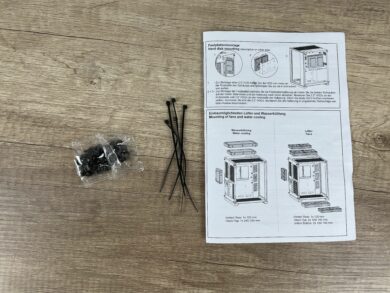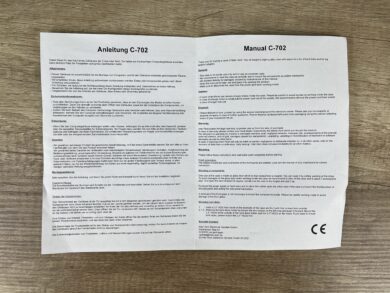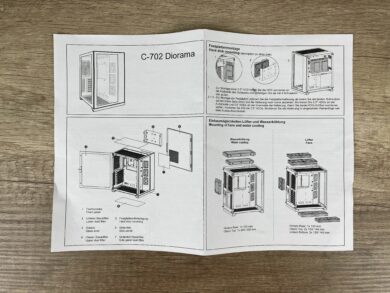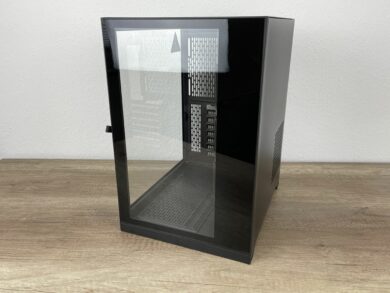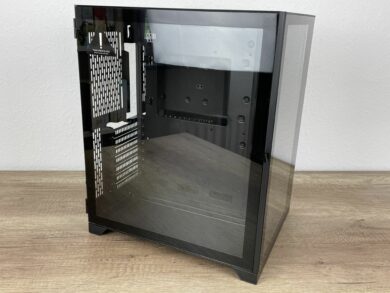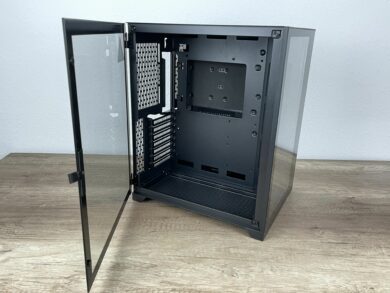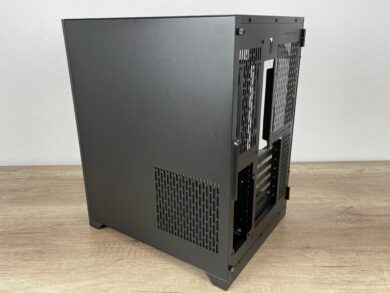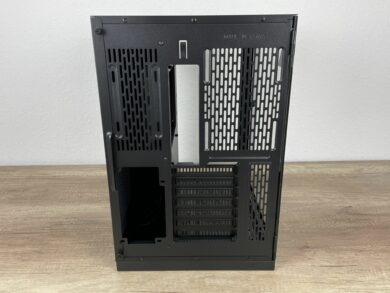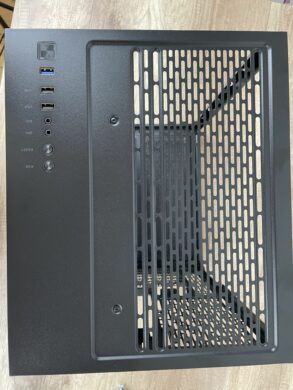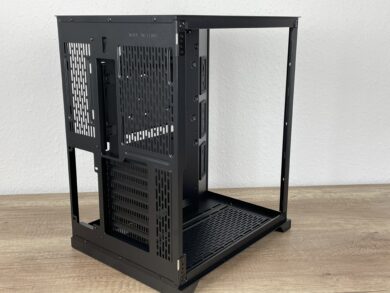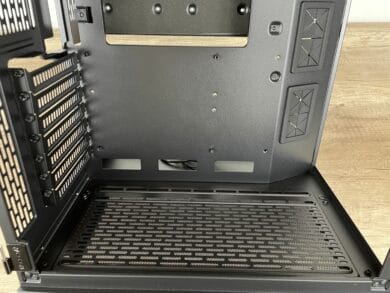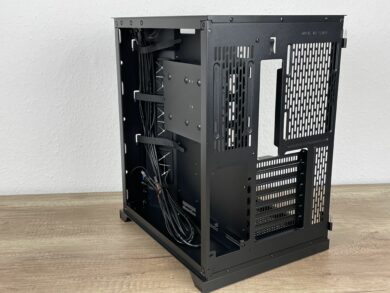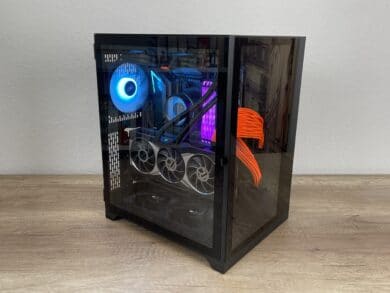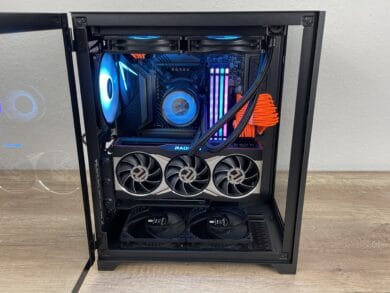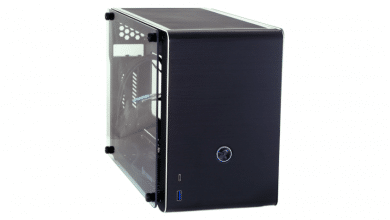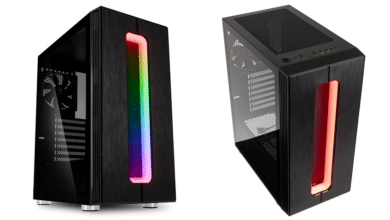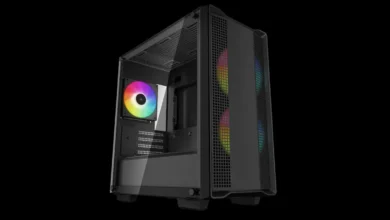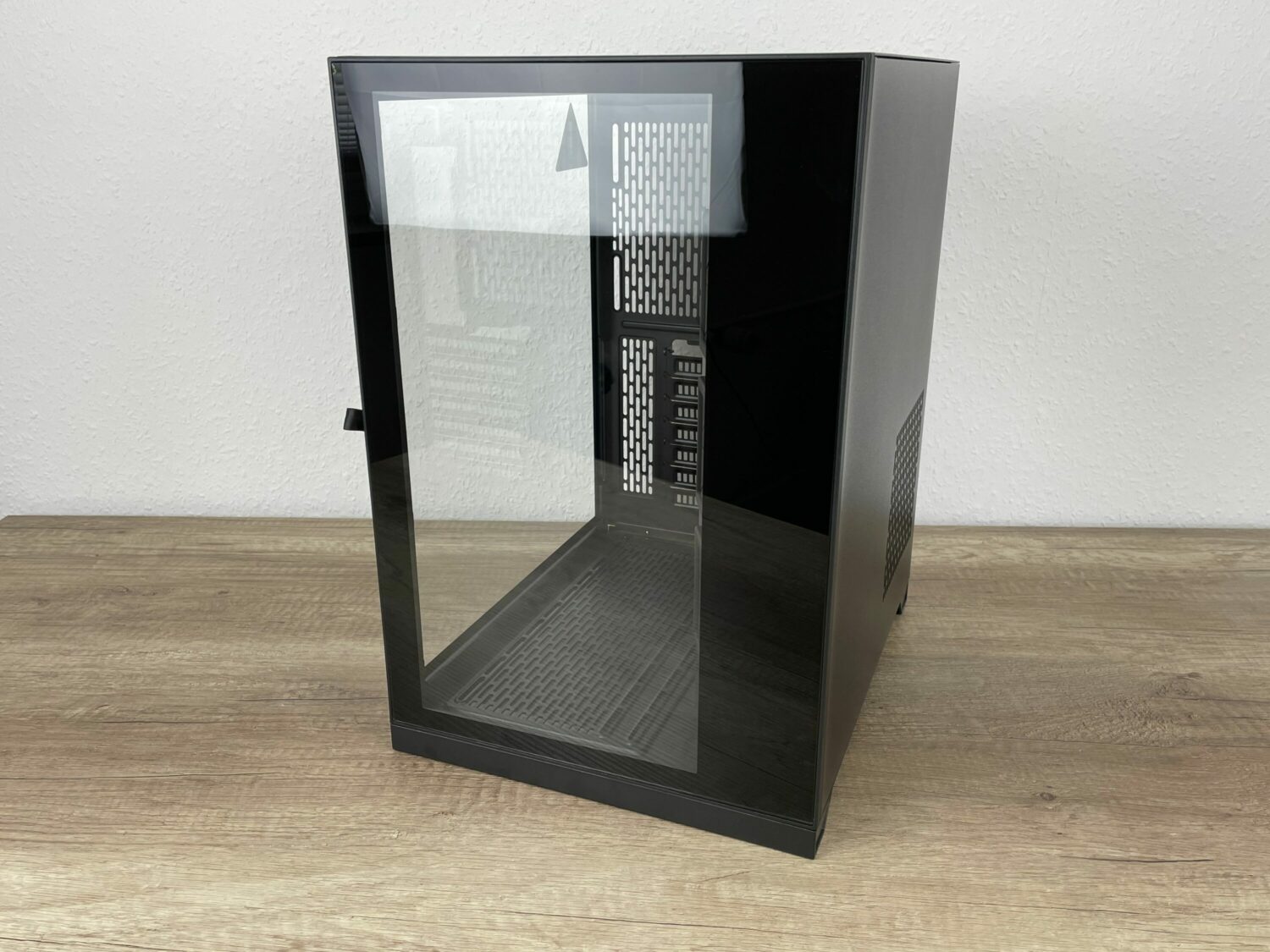
With the C-702 Diorama, Inter-Tech has a more compact variant of the C-701 Panorama on offer. With minor changes inside and out, the main promise is improved usability combined with solid build quality. The technical specifications are promising and guarantee compatibility even with ATX mainboards and large graphics cards. Whether Inter-Tech’s C-702 Diorama could convince, you can find out in the following review.
Specifications
| Model: | C-702 diorama |
| Housing type: | Midi Tower |
| Dimensions (L x W x H in mm): | 360 x 285 x 430 |
| Material: | Steel, glass, plastic |
| Front I/O connectors: | 1x USB 3.0 / 2x USB 2.0 / microphone + headphones |
| Mainboard: | ATX / mATX / mITX |
| Color: | black, black inside |
| Power supply: | ATX |
| CPU cooler (max height): | 160 mm |
| Graphic cards (max. length): | 325 mm |
| Pre-installed fans: | None |
| Possible fans: | Lid: 2x 120 / 140 mm Bottom: 2x 120 / 140 mm Rear: 1x 120 mm |
| Optional radiators (mm): | Lid: 1x 240 / 280 mm Rear: 1x 120 mm |
| Features: | Front and side glass panel. Dust filter, cable management, glass side panel with magnetic closure |
| Price: | € 75.30 * |

Scope of delivery
The accessories are not particularly extensive in design. In addition to the case itself, a sheet printed on both sides is included, on which a rough manual and the warranty conditions are shown. On this, you can see where fans and radiators can be installed. It also shows where the installation of hard drives and SSDs is possible. Also included is a small bag that contains all the necessary screws. Extra cable ties for later cable management have also been thought of.
External impression
The front and side panels are made of transparent tempered glass, while the rest of the case is black. Visually, and this is hard to miss, Inter-Tech’s case strongly resembles Lian Li’s PC-O11. However, it is quite a bit shorter and joins Inter-Tech’s showcase lineup as the “little brother” of the C-701 Panorama. If we take a closer look at the front and the left side panel, we can see a glossy black border that limits the field of view to the essentials and thus covers the metallic parts of the frame as well as the case. This creates a clean look and the hardware is the focus. The glass side panel can be conveniently pulled open with the help of a tab and is held firmly closed by two magnets.
The right side panel has been given a perforation through which the PSU can breathe freely. There are also enough vents on the back to allow the warm air to escape. On the left side of the rear is the PSU bay and above it a possibility to attach an SSD.
If you take a closer look at the C-702 from the top, you can see a large perforation as well as the mounting options for a 240 or 280 mm radiator or two 120/140 mm fans. The whole thing is covered with a magnetic dust grille. On the top side we also find the I/O connectors. Inter-Tech has equipped the Diorama with one USB-A 3.0, two USB-A 2.0 and one headphone and microphone port each. Unfortunately, we cannot find a USB-C port here. The power button, a button for LED control and the reset button are also located here.
Interior
The redesigned interior shines with a covered cable management solution. Unlike the C-701, the second compartment is better sealed, and the pre-installed and rubberized cable grommets also provide some visual privacy. Once the disks are removed, it can seem like the fruit gnomes from childhood suddenly take effect. Because without the discs, the case only weighs an estimated 2 kg.
Despite the compact design, the interior offers enough space, even for high-end graphics cards with a maximum length of 325 mm. The lid offers the possibility to install a radiator. Suitable are 240 mm and also 280 mm radiators. The rear area also offers space for a 120 mm radiator or alternatively a 120 mm fan, the installation of which is recommended. In the bottom, we also have the option of installing two 120mm or 140mm fans. These are a must-have, as they are responsible for the cold air supply from below.
The rear chamber surprises with plenty of space for all sorts of cables. Velcro cable ties have also been thought of, they are pre-installed and in our opinion also positioned sensibly. Two small support surfaces have been created for power supply units, so it has a safe place that is somewhat elevated. In addition, the interior offers enough space in length, even for larger ATX power supplies. Above the PSU opening, it is possible to screw an SSD, directly to the rear panel of the case. A mounting option for two 2.5-inch hard drives or SSDs and two 3.5-inch hard drives has also been created. These are conveniently attached to a carrier behind the processor, and it can also be detached for mounting.
Workmanship
Overall, we noticed the build quality very positively, so we can’t make any criticisms here. The choice of materials was also convincing; for example, the right side panel is made of nicely thick metal and doesn’t look cheap at all. The same goes for the glasses and materials of the rest of the case.
System build & performance test
For our performance test, the following components found a place in the C-702:
- Processor: Ryzen 5 3600*
- Mainboard: MSI MPG B550 Gaming Carbon WiFi*
- Memory: Corsair Vengeance RGB PRO*
- Graphics card: AMD Radeon RX6900 XT
- Vertical Graphics Card Mount: Phantek’s Vertical GPU Mount*, alternatively, of course, the one from Inter-Tech can also be used
- Power Supply: Corsair HX 850*
- AiO: Deepcool Castle 240 EX*
- Cables: LINKUP – PSU Cable Extensions*
Overall, the installation was very smooth and convenient, the detachment of the windshield contributed positively. Nevertheless, we noticed a few negative things. The routing of the cables as well as the connection to the mainboard at the lower connections becomes problematic as soon as fans are installed here. Especially if you choose 140 mm fans, the connections and the feed-throughs are heavily covered. Plugging them in, in conjunction with sensible cable routing of the rigid USB 3.0 connector, thus becomes a challenge. An adapter such as this can help.
As a further point, we would like to note the hoses of the AiO in connection with a vertically installed graphics card. These get in each other’s way, so that the hoses press somewhat against the side panel. You now have to close the pane with a bit of pressure, after which it is held closed by the magnets. However, you don’t have to worry about the pane popping open here.
Cable management
We really liked the cable management and especially the possibility to hide cables. The right chamber is nice and deep, and even under the PSU there is room to route cables. There is also plenty of room behind the hard drive tray for cables and fan controls.
Temperatures
For our performance test, we demanded a bit of something from the installed components. We stressed the processor with the Prime95 stress test for 20 minutes and then repeated this run with different fan speeds. We also subjected the graphics card to a stress test. It was stressed for 20 minutes with the graphics card stress test FurMark. The resulting temperatures can be seen in the table below.
| Fan power | Temperature (°C) processor | Temperature (°C) graphics card |
| 50% PWM | ∅ 74.8 | max. 81 |
| 100% PWM | ∅ 70.1 | max. 77 |
When gaming, of course, the temperatures turn out better. During a round of Call of Duty Warzone in Ultrawide, with maximum settings (ray tracing off) and a 50 percent fan speed of the case fans, the graphics card reached a maximum temperature of 68 °C. Quite solid, in our opinion.
Conclusion
The Inter-Tech C-702 was able to convince us. Our fears that the case could become a hotbox were not confirmed in the performance test. The temperatures remained at a quite acceptable level during the test and also during gaming. The build quality was also convincing, so we cannot voice any criticism here. Overall, however, the C-702 has slight weaknesses in the build (issue of motherboard connections below, paired with 140 mm fans) and the accessories also turn out rather meager. The price of around 70 euros (currently € 75.30 *) puts these criticisms in the shade, however, so you can grab this one heartily.
Inter-Tech C-702 Diorama
Workmanship
Structure
Features
Dampening
Cooling
Value for money
90/100
A compact showcase, with plenty of room for cable management and large graphics cards.




